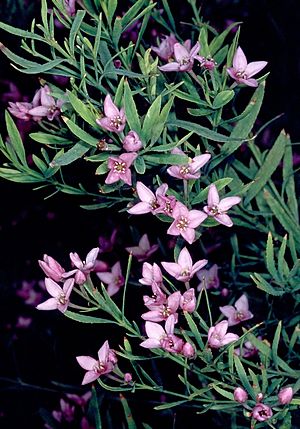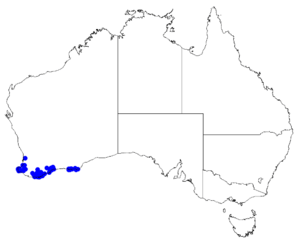Boronia denticulata facts for kids
Quick facts for kids Boronia denticulata |
|
|---|---|
 |
|
| Boronia denticulata in the Australian National Botanic Gardens | |
| Scientific classification | |
 |
|
| Occurrence data from Australasian Virtual Herbarium | |
| Synonyms | |
|
Boronia denticulata is a special plant found only in the southwest part of Western Australia. It belongs to the citrus family, just like oranges and lemons! This plant is a shrub that stands upright. It has long, narrow leaves with tiny teeth along their edges. You can spot it by its pretty pink flowers, which have four petals and grow in bunches at the end of its branches.
What it Looks Like
Boronia denticulata is a thin, tall shrub. It usually grows between 0.5 and 2 meters (about 1.5 to 6.5 feet) high. Its branches are smooth and round.
The leaves are long and narrow, like a line or a small spear. They are usually about 30 millimeters (just over an inch) long. They grow in pairs, one across from the other. You can see tiny teeth along the edges of the leaves.
The Flowers
The flowers grow in groups at the tips of the branches. Each flower sits on a small, club-shaped stalk called a pedicel. There is also a small leaf-like part called a bract near the flower.
Each flower has four egg-shaped sepals, which are like small leaves that protect the flower bud. It also has four pink or pale red petals. Inside the flower, there are eight stamens, which are the parts that make pollen. These stamens are a bit hairy. Boronia denticulata mainly flowers from July to December.
How it Got its Name
The plant Boronia denticulata was first officially described in 1807. A scientist named James Edward Smith wrote about it. He published his description in a scientific book called Transactions of the Linnean Society of London. The plant he studied was collected near King George Sound.
The second part of its name, denticulata, is a Latin word. It means "with small teeth," which describes the tiny teeth on the edges of its leaves.
Where it Grows
This boronia plant loves wet places. You can find it in areas that get wet during certain seasons, like floodplains. It also grows near the edges of swamps, often in water up to 20 centimeters (about 8 inches) deep, alongside plants called sedges.
It mainly grows around the towns of Albany, Bremer Bay, and Esperance. These areas are part of different natural regions in Western Australia, including the Esperance Plains and the Jarrah Forest.
Is it Protected?
The good news is that Boronia denticulata is not considered a threatened plant. The Government of Western Australia's Department of Parks and Wildlife lists it as "not threatened."

